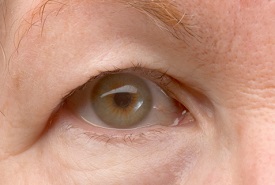Ptosis Treatment in Colleyville, TX

Ptosis is a condition that causes both of your eyelids droop, blocking your vision. Some children are born with ptosis, while others develop it later in life. While not a life-threatening issue, ptosis can be treated to improve your vision and quality of life. To learn more about ptosis treatment in Colleyville, call (817) 203-2760 or contact The New You Medical & Infusion Clinic online.
Ptosis Symptoms
Ptosis can affect one or both eyelids. Signs and symptoms of ptosis can include:
- Droopy eyelids blocking your vision
- Droopy eyelids making you appear tired all the time
- Droopy eyelids forcing you to tilt your head backwards or arch your eyebrows to see better
- Dry or watery eyes
- Dull aching in and around the eyes
Types and Causes of Ptosis
There are two main kinds of ptosis:
- Congenital ptosis, which occurs when the eyelid’s levator muscle doesn’t develop properly in the womb; children born with congenital ptosis may also develop amblyopia—commonly known as lazy eye—or misaligned (crossed) eyes
- Acquired ptosis, which develops after birth
There are several types of acquired ptosis, the most common being aponeurotic ptosis. As people age, the levator muscle that lifts the eyelid can stretch. Aponeurotic ptosis can also be caused by excessive eye rubbing, prolonged contact lens usage, or corrective eye surgery that stretches your eyelid.
Other types of acquired ptosis include:
- Neurogenic: Caused by a disturbance to nerve pathways that control eyelid movement
- Myogenic: This is caused by some form of muscle disease or disorder, like muscular dystrophy or myasthenia gravis respectfully
- Mechanical: This is caused when eyelid is weighed down with excessive skin or mass
- Traumatic: This is caused when the eyelid’s levator muscle is weakened from some form of injury or trauma
You might develop some form of acquired ptosis if you have:
- An infection in the eyelid
- An eye or brain tumor
- A stroke
- A brain aneurysm
- Diabetes
- Horner syndrome
- A stye, which can cause the eyelid to swell
Ptosis Diagnosis
Diagnosis testing for ptosis can include:
- A physical exam including questions about your medical history
- Slit-lamp examination (also known as a biomicroscopy): a low-powered microscope examines your eyes for abnormalities; eye drops may be used to detect abnormalities or dilate pupils
- Tension test for myasthenia gravis: a drug called Tensilon is injected into your vein to check whether your muscle strength improves; if it does, you may have myasthenia gravis
- Visual field testing: these tests measure the function of your peripheral vision and focus as you stare at a screen, one eye at a time.
Your healthcare provider may order blood tests, CT scans, MRIs, and x-rays to diagnose ptosis or rule out other conditions.
Ptosis Treatment
Ptosis treatment includes both non-surgical and surgical methods. A ptosis doctor will help you determine exactly what treatment is best for you.
Non-Surgical Treatments
If your ptosis is being caused by another condition like diabetes, treating that condition will also treat your ptosis. Another popular non-surgical treatment method is the use of a ptosis crutch. This is a type of glasses that holds the eyelid(s) up with crutches fitted on the inside of the frame. Ptosis crutches are safe and effective at improving your vision but are usually most effective when the ptosis is temporary. It may take a while to find the proper fitting, and you may develop dry eyes because the crutches keep your eyelids open. Your eye doctor will help you find the right ptosis crutches and also help you keep your eyelids properly lubricated.
Surgery for Ptosis
Severe, vision-blocking ptosis requires surgery to tighten the levator muscle and lift the eyelid. Extra eyelid skin may also be removed. In children, the eyelid may be lifted via attachment to other muscles.
The following are rare side effects of this kind of surgery:
- Dry eyes
- Eyelids may be positioned too high or too low
- Eyelids may appear asymmetrical
- A hematoma (collection of blood outside a blood vessel) may form
- Eyelid movement may be lost
- The cornea may be scratched
Request Your Appointment Today!
While ptosis can lead to blocked vision, there are many potential treatments to investigate. To learn where you can find an eye doctor in Colleyville, call (817) 203-2760 or contact The New You Medical & Infusion Clinic online.
The New You Medical & Infusion Clinic
Address
100 Grapevine HwyHurst, TX 76054
(817) 203-2760
https://www.newyoumedclinic.com/
Hours
Mon:
10:00 am - 6:00 pm
Tue:
10:00 am - 6:00 pm
Wed:
10:00 am - 6:00 pm
Thu:
10:00 am - 6:00 pm
Fri:
Closed
Sat:
Closed
Sun:
Closed

